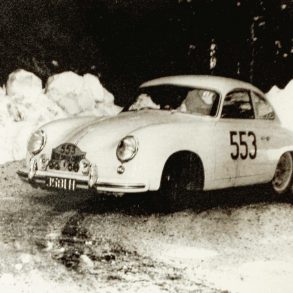Ever wanted to know how to detail a car so that it looks like it has just been driven out of a showroom? Master-Detailer, Daniela Friedl, reveals the secret to achieving the perfect result.
Just one glance at Daniela Friedl while she actively detailing cars shows the passion Friedl has for cars.
As she slides her cleaning pad over the sides of the Porsche 911, just sufficiently firm enough to eliminate any marks, there’s a trace of kindness. Despite having a great passion for cars, she has no love for grime over vehicles- the focus of her business.
Daily, Friedl faces all kinds of dirt and grease: tar spots on the paintwork, bird droppings, dirt that sprays around the edges of the wheel arches, brake dust, surface rust, dead insects on the windows and windshields, oily patches on the engine, and grease marks on the leather upholstery. If one considers dirt an enemy, Friedl faces an army each working day, but the battle is never lost.
“For me, cars are like guests, and you do your best for them,” says Friedl, who works at the Swissvax Car Spa in Baierbrunn, at the Munich suburb. Friedl’s schedule is always full, most especially in spring, when the customers require her skills to make their cars look fresh again after a long winter.

When it comes to auto detailing, Friedl frequently works on a car for two to three days for a complete detail and focuses solely on one vehicle at a time.
“We do this job as our profession, but there are a lot of things you can do at home too if you follow a specific checklist,”
Friedl offers her expert knowledge in how to detail a car so your car too can restore its beauty similar to a car detailing service.
1. Begin with Hand Washing
Car washing must begin with a thorough hand wash. In German towns and cities, people are not allowed to wash their cars privately in most towns and cities, so she recommends a self-service ‘wash box.’ Friedl doesn’t advise going to an automatic car wash as they can leave fine scratches and swirl marks on the paint surface, and for her, scratches are much like dirt, “they take away a lot of the shine and form ugly holograms.”

While working on the Porsche 911 car’s exterior, she sprays it with water and then proceeds to lather it from top to bottom using a concentrated pH-neutral shampoo in a bucket of warm clean water (soapy water). With a pad in hand, she runs it up and down the car as she works.
“The first rule is always work in vertical or horizontal lines,”
Circular movements create micro-scratches in the car’s paint which she dislikes (swirl marks). She also gives a tip against conventional sponges, stating, “the particles in the sponge cause tiny new scratches.” Alternatively, Feidl suggests using a sponge with a cotton cover.

Her second rule is that if a cleaning cloth drops on the ground, promptly replace it with a clean one. Never pick it up and make contact with the car’s paint.
Her third rule is to keep the car wet throughout the washing process. Friedl progresses to rinse the car and uses a rubber scraper to remove the water. She uses compressed air to blow away the moisture that is in the nooks and crannies, like within the door panels. She then rubs it dry with a clean cloth, still rubbing it horizontally or vertically.
Her method to make a tire shine is to utilize a cleaning brush and a specific wheel cleaner before drying them with a cloth.

Despite the Porsche 911 being constructed back in 1986, it is starting to regain its former glory, with the owner glowing too. For Friedl, however, her work has just started.
“Most customers are a bit too optimistic about the condition of their car’s paintwork.”
Speaking from experience, she brought out a small LED lamp that revealed the micro-scratches on the car’s paintwork, showing numerous fine scratches and swirl marks. “We’ll get rid of those,” she stated as she rubbed the surface of the car with a clay bar.

2. The Clay Bar
The next step you need to know in how to detail your car is utilizing a clay bar. Friedl uses a detailing clay, which is considered by those within the industry as something of a miracle tool that eliminates unwanted deposits on the paint surface.

Using it on the whole car will demand a lot of elbow grease combined with good technique. The clay must be pushed back and forth with light pressure while being applied- but the results speak for themselves.
Friedl demonstrated the results by slipping her fingers in a thin plastic pocket and then running it across both the treated and untreated areas actually to feel the difference between them.

3. Cleaning Fluid
Upon using the clay bar, Friedl moves on to applying a cleaning fluid (Swissvax cleaner fluid) to remove residual deposits without harming healthy paintwork.
There is a logic to separate residues and paint this way. Friedl states:
“Standard products often combine cleaning and polishing. But you usually pay for it with a higher paint removal rate.”
Friedl uses a professional polishing machine; however, she ensures to cover the plastic and rubber parts while using it because white polish marks on a car’s finish are difficult to remove.


The fluid is wiped off with a microfiber cloth almost as soon as it is applied. The part treated with cleaning fluid and removed with a microfiber towel displays a beautiful shine especially when it is compared to its untreated parts.
The paintwork seems deeper, and its shape looks more sculpted. When the paint is stroked, it squeaks. She grins, “that’s the sound of restoration.”
The same process of clay and cleaning fluid is also used on the wheels. “It goes without saying that wheels should be kept looking smart,” she shared.
She uses a special rim cleaner wax which is then polished off after ten minutes. The car’s plastic and rubber parts are also given special treatment with the use of a plastic cleaner applied using a paintbrush, brush, or cloth, and then a deep care treatment. Friedl stated, “It’s like skincare. You always apply a cream to your face after cleansing.”

For the engine, she uses a water-soluble engine cleaner before spraying a sealant which is left to sit for at least two hours.
4. Car Interior
When it comes to the car’s interior, Friedl states:
“This is the point where many car owners start to run out of steam, but a car always shines from the inside out.”
The interior detailing begins with the mats and carpet, which are given the full steam cleaner treatment.

The upholstery, however, is assigned a specialist leather cleaner, spraying it on the interior surfaces before massaging it with a brush. The results are stunning, and it does not take long for the surface of the leather to become semi-matt from shiny.

5. Sealing the Paintwork
Sealing the paintwork is the grand finale and Friedl utilizes a jar labeled ‘Zuffenhausen’. This contains a wax called Carnauba wax, which is natural and not a synthetic wax.
She takes a pea-sized bead of wax and rubs it between her palms. She warms it up and then users her bare hands to massage the wax into the flank of the Porsche, very similar to a physiotherapist would apply Arnica oil to the legs of athletes.
“A Porsche has perfect curves, so I really enjoy this bit,” Frieldl admits as she lets the wax work for five to ten minutes before she briefly and gently polishes it.
The car is now radiant, and its glowing extends from the paintwork of the exterior, the wheels, the engine, to even the leather upholstery and plastic elements. Friedl smiles:
“It’s shining from within. Spring is in the air.”
[Source: Porsche AG, Photos courtesy of Porsche AG]











Please come and do mine!
It needs some of your TLC
Wait, “In German towns and cities people are not allowed to wash their cars privately. ” ?!?!!!
What is the cleaning fluid that is used in step three?
Swissvax Cleaner Fluid